
 Home Home |
 For authors For authors |
 Submission status Submission status |
 Current Current
|
 Archive Archive
|
 Archive
(English) Archive
(English)
|
 Search Search |
The paper presents the results of a study of tunneling transport in macroscopic vertical van der Waals heterostructures based on bilayer graphene (BLG). The equilibrium tunneling conductivity was measured between two BLG sheets whose crystal lattices are rotated relative to each other by a small angle of ≈ Q ~ 0.7°, which imposes certain restrictions on the possibility of interlayer tunneling with energy and momentum conservation. The tunneling boundaries on the experimental conductivity map depending on the gate voltages are well described by the model, which takes into account the electrostatics of the system and tunneling at the Fermi level between the BLG sheets.
Anomalous in amplitude asymmetric peaks of conductivity were detected at the boundaries of the tunneling region, which we associate with the manifestations of van Hove singularities at the edges of the conduction band and the valence band near the gap formed in bilayer graphene under the influence of an electric field. The sharp asymmetry of such peaks is consistent with the spatial localization of van Hove singularities in different monolayers of bilayer graphene in a perpendicular electric field.
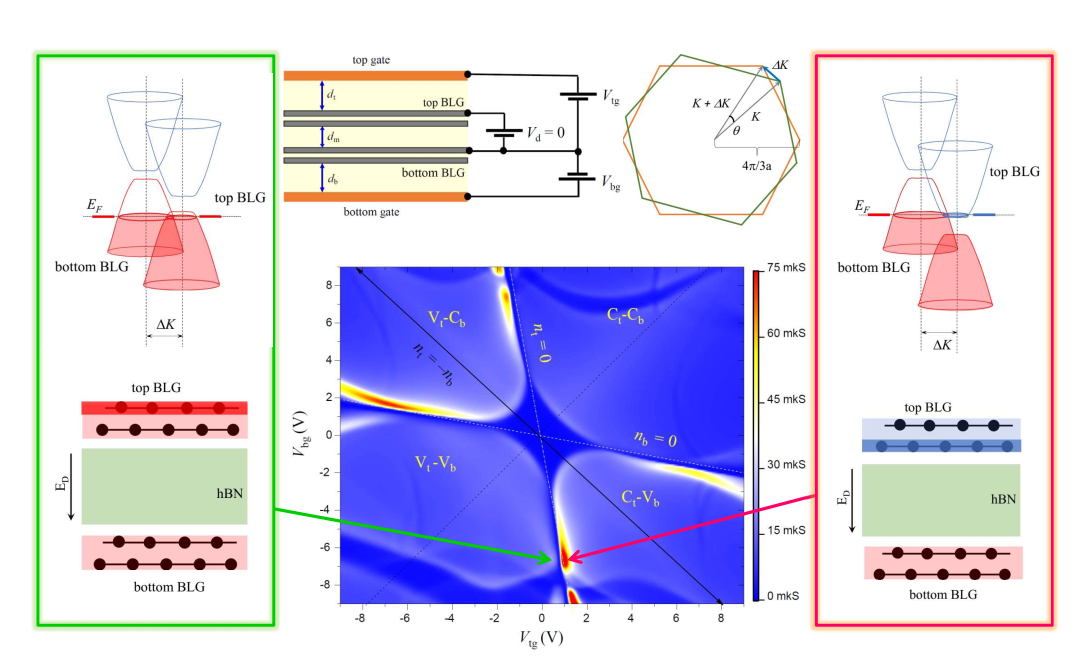
Schematic of dual-gated BLG/hBN/BLG device and measured map of tunneling conductance (in the center) as function top and bottom gate voltages. The tunneling is forbidden in the central part and displays prominent peaks near the charge neutrality points shown by dotted lines. Right and left pictures describe asymmetric situations from both sides of the charge neutrality: enhanced tunneling thanks to electron wave function in top BLG being pulled closer to the bottom BLG (right), and suppressed tunneling due to the opposite displacement of the wave function (left).
E.E.Vdovin et al.,
JETP Letters 120, issue 11 (2024)
The search of super-rare decay $K^+ \to \pi^0\pi^0\pi^0 e^+ \nu$ is performed by the OKA collaboration. No events of the searched process observed, the upper limit set:
$Br < 5.4 \times 10^{-8} ~ 90\%$ C.L. is currently the world's best one. The previous value listed in Particles’ Table (PDG) is 65 times worse. The decay is sensitive to New
physics. The search of this decay turned out background-free which paves the road for future high-statistics experiments. The result will be published in JETP Letters
and presented at the international conference ICPPA-2024.The upper limit on the $K^+ \to \pi^0\pi^0\pi^0e^+\nu$ decay
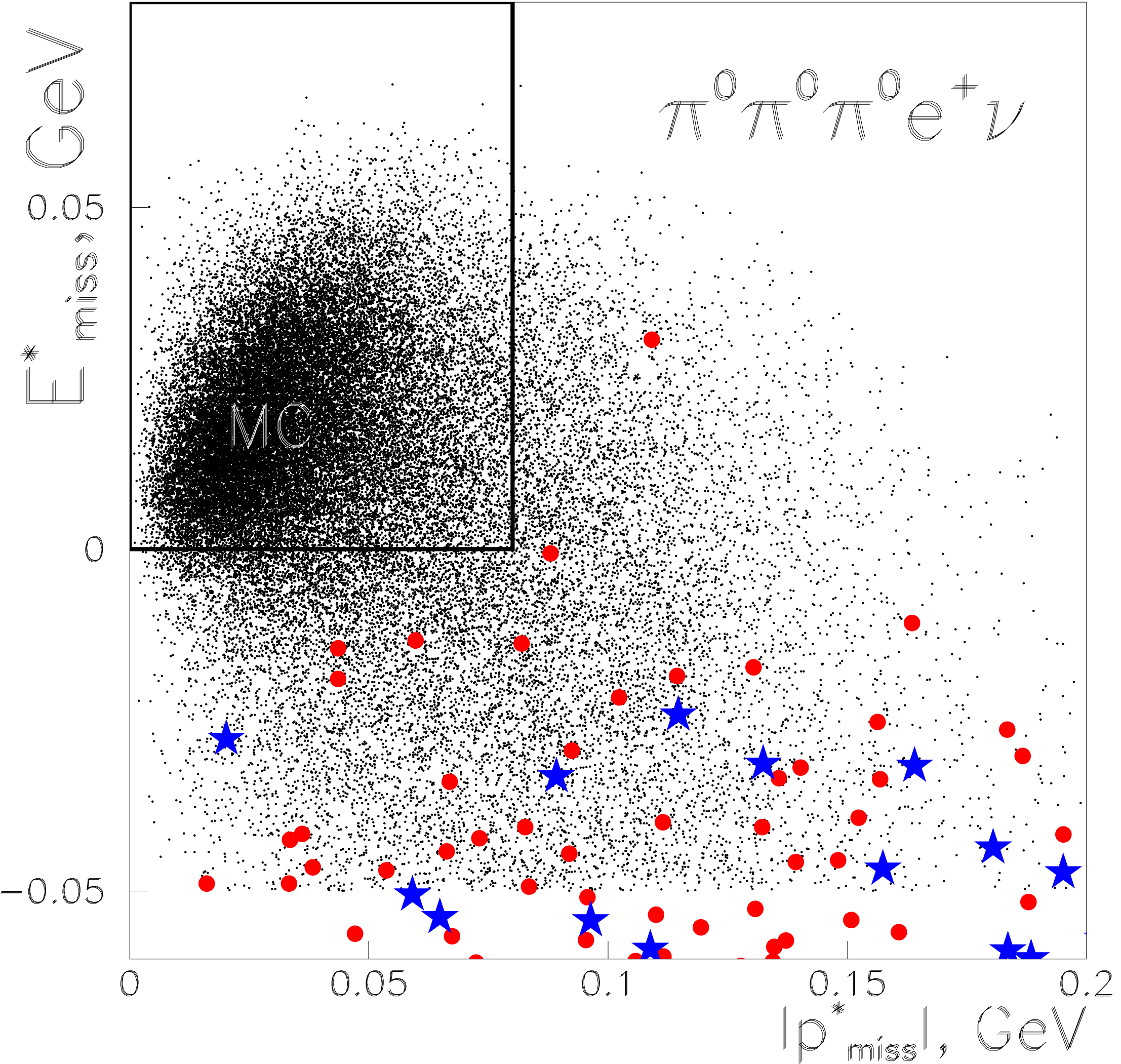
Search for the $K^+ \to \pi^0\pi^0\pi^0e^+\nu$ decay. Missing momentum and missing energy in the $K^+$ rest frame: data (red bullets), MC simulation of backgounds (blue stars) and MC simulation of signal (dots).
The vast majority of the decay events are expected within the area marked with the rectangle.
A. V. Artamonov, V. N. Bychkov, S. V. Donskov et at.,
JETP Letters 120, issue 8 (2024)
The appearance of intense pulsed sources of terahertz (THz) radiation has generated the increasing interest in their influence on metal nanofilms, including ferromagnetic ones, which are components of THz optics and spintronics devices. In this field, one of the most important tasks is to study energy transport between the electrons and lattice at a nanoscale in the time domain under the irradiation of intense THz pulses.
In this work, using a hybrid pump-probe scheme of femtosecond interference microscopy, as a combination of the sample excitation by a subpicosecond THz pulse and of visible femtosecond probe pulses, the relaxation of the electron and lattice in a 25 nm thick nickel film sample near the melting point was explored.
The increase in reflection of the probe pulse at the moment of action of the THz pump pulse with a duration of 0.7 ps and a strength of 11 MV/cm is induced by the raise of the electron-electron collisions frequency in case of nonequilibrium heating, when electron temperature $T_e $ exceeds the lattice temperature $T_i$. The subsequent decrease in reflection during several picoseconds is caused by the heating of the lattice at the stage of temperature equilibration between $T_e $ É $T_i $. The variation of the complex permittivity indicates the onset of the nickel film melting in 5-10 ps after the THz exposure. The morphological studies by scanning electron and atomic force microscopy showed the surface modification of the film with a significant increase in its roughness after heating, apparently associated with the dewetting effect.
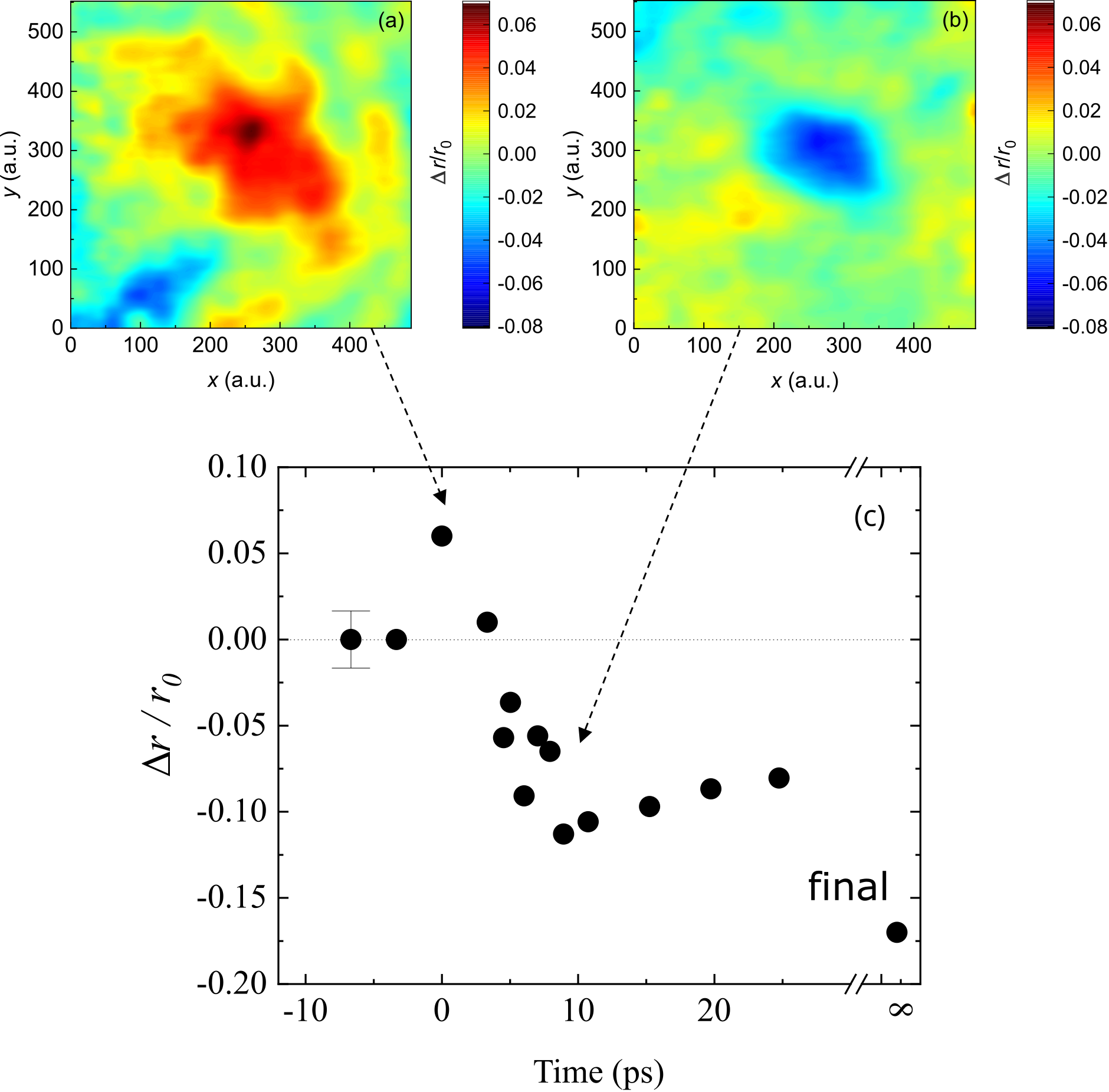
Fig 1 Spatial distributions of the reflectivity changes of probe for a time delay: a) - 0 ps, b) - 6.7 ps; c) - normalized reflection coefficient of the probe from the nickel film vs time.
S. I. Ashitkov, P. S. Komarov, A. V. Ovchinnikov, S. A. Romashevskiy,, E. V. Struleva, O.V. Chefonov, M. B. Agranat
JETP Letters 120, issue 8 (2024)
It is known that quantum effects can manifest themselves at the macroscopic level in anisotropic magnets with low critical temperatures of magnetic ordering. The physical reason for the difference between the results of the phenomenological approach for such materials and the results of the quantum theory is the crystal field, leading to mixing of the states with different spin projections.
In this paper, we show that the experimentally observed features of the low-temperature behavior of the magnetization of the van der Waals topological antiferromagnet MnBi2Te4 [1, 2] in an external magnetic field, oriented perpendicular to the layers of manganese ions, are due to the quantum effects caused by the nondiagonal nature of the trigonal component of the crystal field. In this case, the anomalous increase in the magnetization of MnBi2Te4 before the spin-flop transition, as well as after it in the phase of collapsed sublattices, is explained by the influence of the magnetic field on quantum fluctuations.

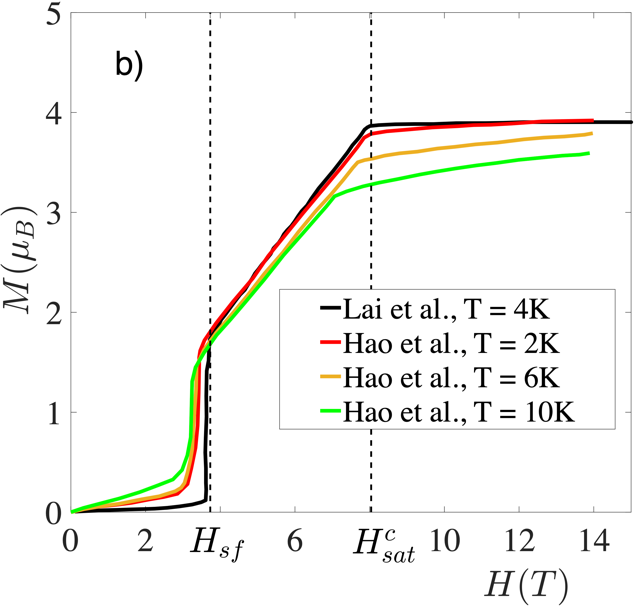
The theoretical dependences of the magnetization obtained considering the quantum effects are shown in Figure (a). They correlate well with the experimental data [1, 2] presented in Figure (b). The increase in the magnetization before the spin-flop field Hsf and after the saturation field Hcsat is determined by the quantum effects associated with the trigonal component of the crystal field.
1.Y.-J. Hao, P. Liu, Y. Feng et al., Phys. Rev. X 9, 041038 (2019).
2.Y. Lai, L. Ke, J. Yan et al., Phys. Rev. B 103, 184429 (2021).
V.V. Val’kov, A.O. Zlotnikov, A. Gamov, N.A. Fedorova, F.N. Tomolin,
JETP Letters 120, issue 7 (2024)

JETP Letters 120, issue 7 (2024)
In the absence of reliable experimental data, theoretical studies became the primary approach to understanding neutral excitations in fractional quantum Hall states. An analogy between the lowest-energy excitations of certain fractional states (Laughlin liquids) and gravitons - quanta of the gravitational field - was discovered theoretically. For this reason, the lowest-energy neutral excitations of Laughlin liquids with zero momentum are called chiral gravitons or magnetogravitons. Previously, the authors proposed a technique that uses light reflection to detect analogs of chiral gravitons in the Laughlin liquid. Those are neutral excitations with a change in the spin quantum number of the electron system by one - spin-magnetogravitons (SMG). It turned out that SMGs with zero momentum can have unprecedentedly long lifetimes, although the relaxation dynamic of these excitations is non-monoexponential. This suggests that the description of the SMG system as an ensemble of identical, non-interacting quasi-particles is insufficient to explain the existing experimental data.
In this paper, we investigated the long-term relaxation of SMG ensembles in a Laughlin liquid at an electron filling factor of 1/3. Studying the time dynamics of such long-lived excitations presents a significant experimental challenge. To address this, the resonance reflection (RR) technique and coherent anti-Stokes-Stokes Raman scattering of light (aSSR) were employed. Both scattering processes contribute to the reflection spectrum, but their intensities vary differently on the change in the excitation power. The RR signal is linear across the full range of powers, while the aSSR signal exhibits a nonlinear dependence on the excitation power due to the formation of the SMG ensemble. As a result of measuring the relaxation processes of SMGs at different laser powers and excitation spot sizes, it was shown that there are two types of these excitations (bright and dark). The lifetimes of dark SMGs can reach hundreds or thousands of seconds at a temperature of 0.6 K, whereas the lifetimes of bright SMGs are less than one second. The maximal amount of SMGs diluted in the Laughlin liquid is constant, but the ratio of the dark and bright SMGs can be varied experimentally by rising the SMG density. It seems the dark SMGs are quasi-particles organized in a novel condensed state in the Laughlin liquid.
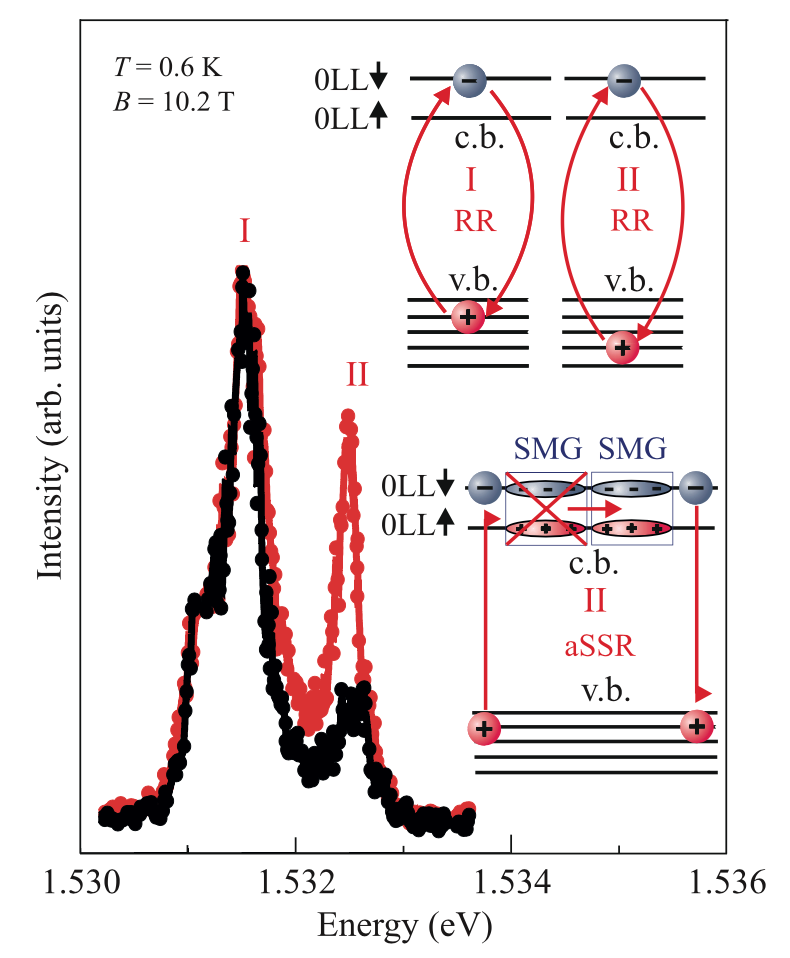
Reflection spectra of the Laughlin liquid at the electron filling factor 1/3 at different laser excitation powers (black dots represent weaker excitation, red dots represent stronger excitation). The diagrams show the processes of resonance reflection (RR) and anti-Stokes-Stokes Raman scattering (aSSR).
A.V.Larionov et.al,
JETP Letters 120, issue 6 (2024)
Future development of nuclear energy forsees implementation of a closed fuel cycle in the 4th generation nuclear power plants and Accelerated Driven System (ADS-systems), i.e. nuclear reactors driven by high-current proton accelerators with energies of about 1 GeV for burnup of long-lived isotopes in spent fuel. We report precision measurements of the 237Np fission cross section in the neutron energy range of 0.3-500 MeV using the time-of-flight spectrometer GNEIS created on the basis of the SC-1000 synchrocyclotron at the NRC “Kurchatov Institute” – PNPI. The fission cross section of 237Np was measured relative to that of the reference nucleus 235U. The uncertainty of the obtained ratio was 2-3%. The results cover both the range of 0.3-20 MeV (the reactor spectrum), which is important for today's and near-future nuclear technologies, and the more challenging area of 20-500 MeV, which is critical for the development of advanced ADS technologies.
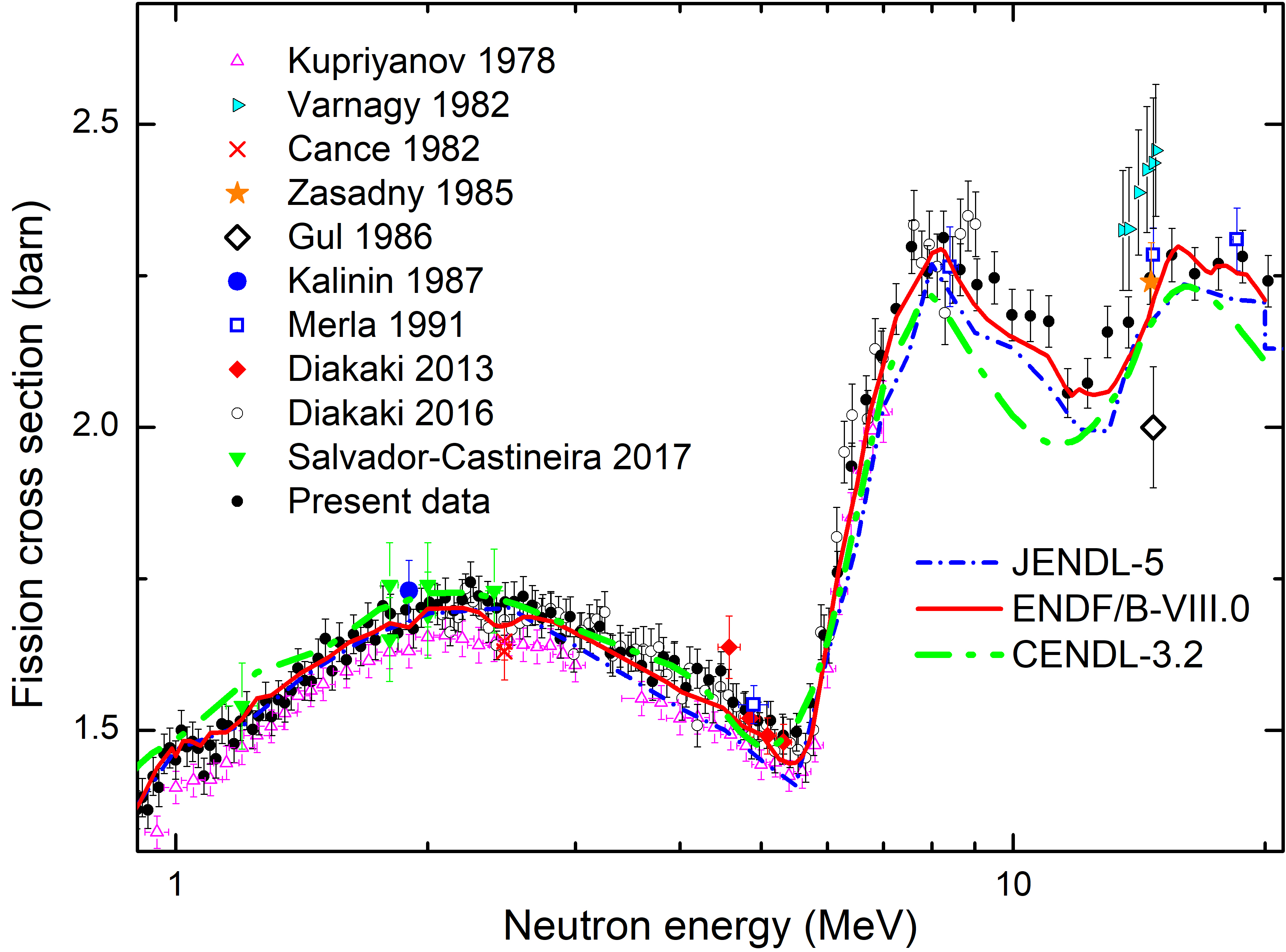
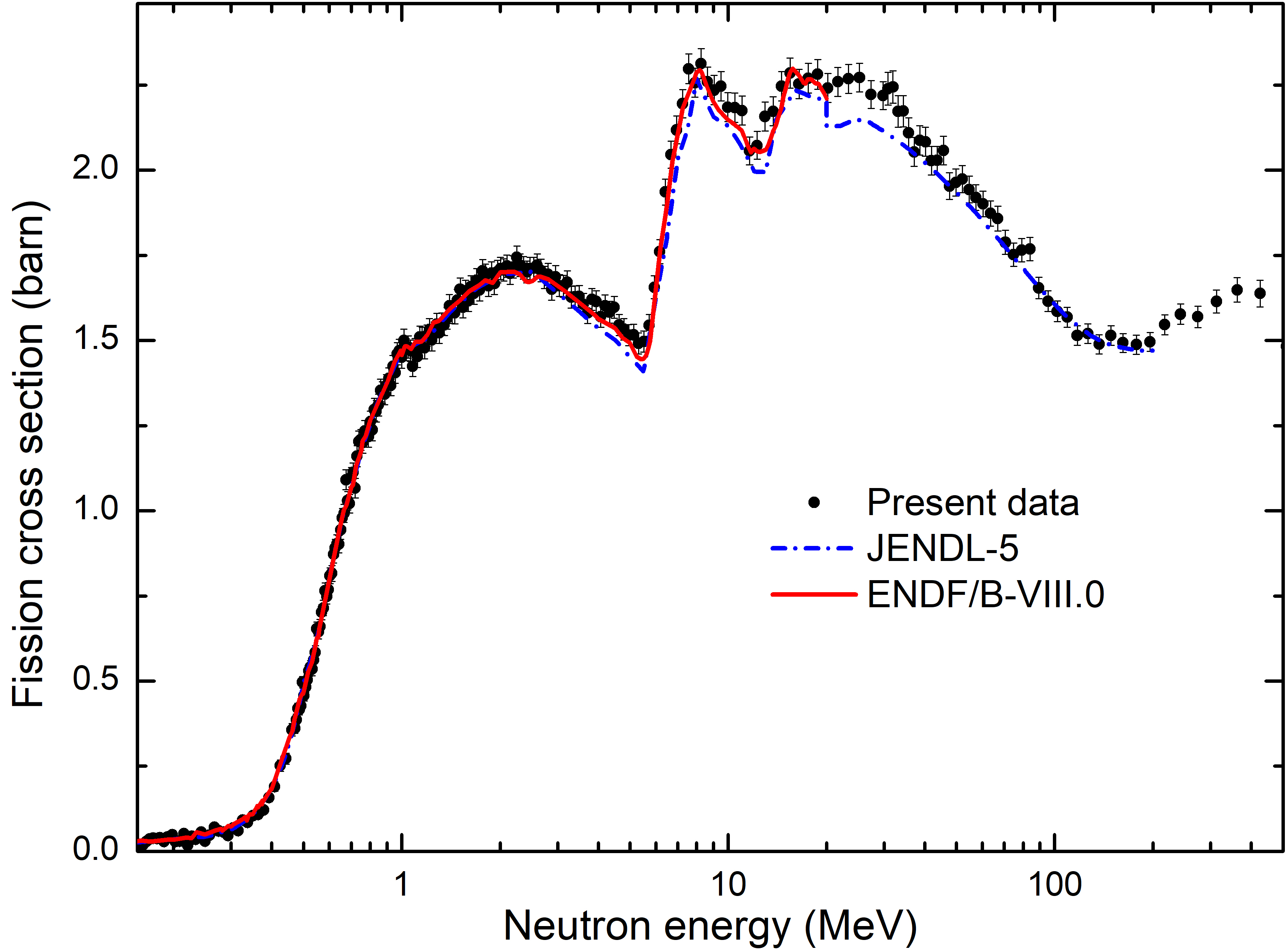
Figures 1 and 2. 237Np fission cross-section in comparison with the results of other studies.
Vorobyev A.S., Gagarski A.M., Shcherbakov O.A., Vaishnene L.A., Tiagelskaia A.M., Olkhovich N.M., Barabanov A.L.
JETP Letters 120, issue 6 (2024)
The research paper provides the classification of resonant interactions of a coherent field with an anharmonic oscillator using the established analogy with multiphoton interactions of light with atoms. In this context consideration is given to the characteristic nonlinear terms in the Hamiltonian, which change the state of the anharmonic oscillator by means of a certain number of quanta p. The interference interaction, in which the absorption of one quantum of a coherent field leads to a multiquant transition in an anharmonic oscillator due to electrodipole interaction and nonlinearity, manifests itself both as the superposition of resonances of the cascade type and the lambda-V type. Taking into account the nonlinearity of the third and fourth orders, the general formulas are applied to a resonant process of absorption of one photon and two-fold excitation of the oscillator. This resonance is a superposition of interference resonances of cascade type (nonlinear term with p=1) and lambda type (nonlinear term with p=3, see Fig.).

The resonant processes of both second harmonic and low-frequency generation of emission are predicted and described, with its experimental study of nutations allowing us to estimate the parameters of anharmonicity of the considered model. The analogy and effective resonant operators are obtained using algebraic perturbation theory, which differs from the canonical Van Fleck perturbation theory, for example, by requiring the absence of time-varying terms in the effective Hamiltonian in the Dirac picture.
Basharov A.M.
JETP Letters 120, issue 6 (2024)
The first experimental results on the polarization of inclusively produced Λ-hyperons in the 𝐾−- and 𝜋−-beams with a momentum of 26.5 GeV/𝑐 were obtained at the SPASCHARM facility at the U-70 accelerator complex in NRC “Kurchatov institute” – IHEP (Protvino). The polarization of Λ-hyperons in the 𝜋−-beam does not exceed several percent in most of the studied kinematic region, with the exception of the region 𝑝𝑇>1 GeV/𝑐, where the polarization is 23±9%. For 𝐾—mesons incident on nuclear targets, in the region of large values of the Feynman variable 𝑥𝐹 and the transverse momentum 𝑝𝑇, a substantially larger positive polarization was observed for the first. In the region 𝑝𝑇>0.3 GeV/𝑐 the average polarization PN = is 23.6 ± 3.6%, which is a 6.5 sigma effect. In the region 𝑝𝑇>1 GeV/𝑐 polarization reaches 66 ±18%.
The observed spin effects may have a non-perturbative nature, associated with spontaneous breaking of chiral symmetry in QCD with formation of constituent quarks with mass of about 300 MeV and a large negative (-0.4) anomalous chromomagnetic moment, which could polarize quarks via the Stern-Gerlach effect in a non-uniform chromomagnetic fields.
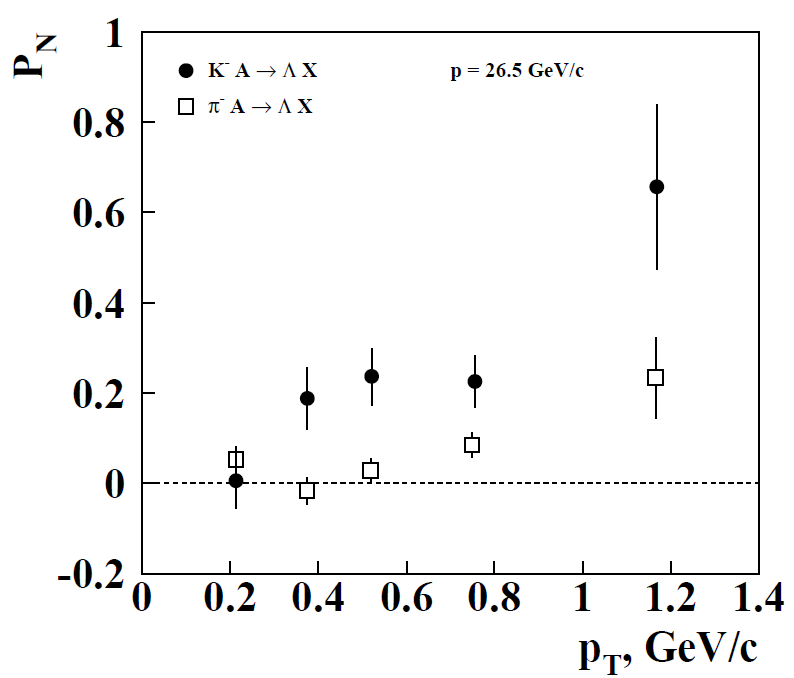
Dependence of 𝑃𝑁 on the transverse momentum 𝑝𝑇 in the reactions 𝜋−𝐴 → Λ𝑋 and 𝐾−𝐴 → Λ𝑋, obtained at an energy of 26.5 GeV at the SPASCHARM experimental facility at the U-70 accelerator complex in Protvino.
V.V. Abramov, V.V. Moiseev, I.G. Alekseev, N.A. Bazhanov et al.
JETP Letters 120, issue 6 (2024)
A new class of altermagnetic materials has been added to usual ferro- and antiferro- magnetic classes by extending the concept of spin-momentum locking to the case of weak spin-orbit coupling, i.e. to the non-relativistic groups of magnetic symmetry. For altermagnetics, the small net magnetization is accompanied by alternating spin-momentum locking in the k-space, so the unusual spin splitting is predicted.
For example, RuO2 altermagnet consists of two spin sublattices with orthogonal spin directions. In the k-space, the up-polarized subband can be obtained by π/2 rotation of the down-polarized subband, so RuO2 altermagnet is characterized by d-wave order parameter. Experimental investigations can be conveniently performed for MnTe altermagnetic candidate, which is characterized by accessible (2–3 T) magnetic field range in contrast to RuO2 altermagnetic.
For some altermagnetic candidates, anomalous Hall effect (AHE) has been experimentally demonstrated in a few early experiments, despite of the expected zero non-relativistic net magnetization. It has been argued theoretically, that the spontaneous nature of the AHE still requires relativistic spin-orbit interaction. Thus, inconsistency between the expected zero non-relativistic net magnetization and ambiguous experimental behavior requires comprehensive magnetization measurements in altermagnetics in wide temperature and magnetic field ranges.
Here, we experimentally study magnetization reversal curves for MnTe single crystals, which is the altermagnetic candidate. Below 85 K, we observe the sophisticated angle dependence of magnetization M(α) with beating pattern as the interplay between M (α) maxima and minima in the external magnetic field. This angle dependence is the most striking result of our experiment, while it cannot be expected for standard magnetic systems. We claim that our experiment shows the effect of weak spin-orbit coupling in MnTe, with crossover from relativistic to non-relativistic net magnetization, and, therefore, we experimentally confirm altermagnetism in MnTe.
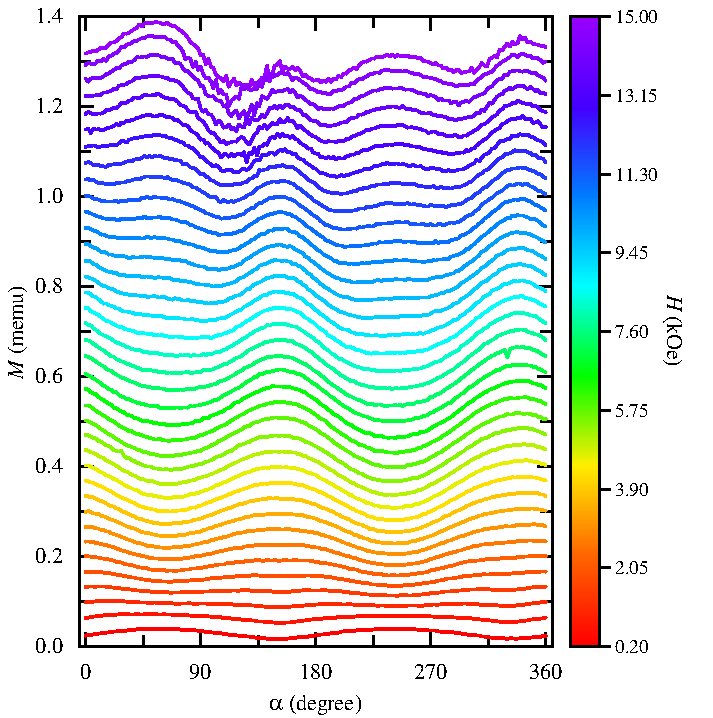
Crossover from ferromagnetic to antiferromagnetic behavior shown as M(α) curves in different magnetic fields. In low fields (around 0.2 kOe), M(α) shows ferromagnetic-like 180◦ periodicity. At high magnetic fields (around 15 kOe), the periodicity is changed to the antiferromagnetic 90◦ one. For the intermediate fields (around 6 kOe), one can see interplay between the maxima and the minima in M(α) curves.
Orlova N.N., Avakyants A.A., Timonina A.V., Kolesnikov N.N., Deviatov E.V.,
JETP Letters 120, issue 5 (2024)